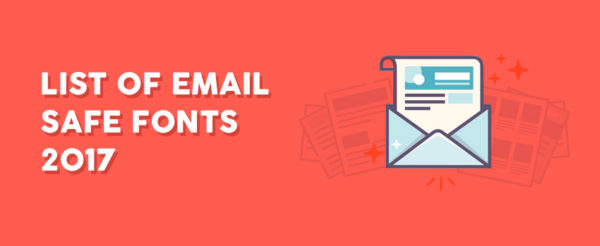When it comes to designing email templates, fonts play a crucial role in delivering the right message with a visually appealing look. However, unlike websites, emails are more restricted in terms of font usage due to email clients not always supporting custom fonts. This is where email safe fonts come into play.
Email safe fonts are standard fonts that are widely supported across most email clients, ensuring your email’s typography remains consistent and readable. In this article, we will discuss why email safe fonts are important, which fonts to use, and how to ensure your email design remains intact across different platforms.
Why Email Safe Fonts
Emails are opened in a variety of clients such as Outlook, Gmail, Apple Mail, and Yahoo Mail. Each of these clients has different levels of support for custom fonts. If a font isn’t supported, the email client will default to a substitute font that may not align with your design, which can affect readability and overall presentation.
Using email safe fonts ensures:
- Consistency: Your email looks consistent across different clients and devices.
- Readability: The fonts are legible, making it easier for recipients to read your message.
- Professionalism: A polished, well-formatted email enhances your brand’s image and engagement.
The Best Email Safe Fonts to Use
Here’s a list of widely supported email safe fonts that will work across almost all email clients:
| Serif, Serif , Serif, Serif |
| sans-serif, sans-serif, sans-serif, sans-serif |
| Monogram, Monogram 5, Monogram, Monogram |
| Calligraphy , Calligraphy, Calligraphy, Calligraphy |
Email-safe fonts include Arial, Georgia, Helvetica, Lucida, Tahoma, Times, Trebuchet, and Verdana.
Here is the list of standard set of fonts common to all versions of Windows and Mac.
| Normal style |
|---|
| Arial, Arial, Helvetica, sans-serif |
| Arial Black, Arial Black, Gadget, sans-serif |
| Comic Sans MS, Comic Sans MS5, cursive |
| Courier New, Courier New, monospace |
| Georgia1, Georgia, serif |
| Impact, Impact5, Charcoal6, sans-serif |
| Lucida Console, Monaco5, monospace |
| Lucida Sans Unicode, Lucida Grande, sans-serif |
| Palatino Linotype, Book Antiqua3, Palatino, serif |
| Tahoma, Geneva, sans-serif |
| Times New Roman, Times New Roman, Times, serif |
| Trebuchet MS1, Trebuchet MS, sans-serif |
| Verdana, Verdana, Geneva, sans-serif |
| Symbol, Symbol (Symbol2, Symbol2) |
| Webdings, Webdings (Webdings2, Webdings2) |
| Wingdings, Zapf Dingbats (Wingdings2, Zapf Dingbats2) |
| MS Sans Serif4, Geneva, sans-serif |
| MS Serif4, New York6, serif |
1. Arial
Arial is one of the most commonly used fonts across web and email design. It’s a versatile, sans-serif font that is easy to read on any screen size.
2. Times New Roman
For a more traditional, serif look, Times New Roman is a classic option. It’s often used for text-heavy emails or formal business communications.
3. Helvetica
Helvetica is another popular sans-serif font that is similar to Arial but offers a slightly more refined look. It’s a clean, modern choice for emails.
4. Georgia
If you need a serif font that works well for both titles and body text, Georgia is a good option. It is elegant and widely supported across email clients.
5. Tahoma
Tahoma is a sans-serif font that is known for its excellent legibility, especially on smaller screens. It’s a great option for mobile-friendly email designs.
6. Verdana
Verdana is designed specifically for screens, making it an ideal choice for email. It features wide letter spacing and is very easy to read, even at smaller font sizes.
Fallback Fonts and Font Stacks
Even when using email safe fonts, it’s essential to define fallback fonts in your CSS. Fallback fonts ensure that if the primary font doesn’t load, a similar alternative will be used instead. Here’s an example of a font stack for email:
font-family: Arial, Helvetica, sans-serif;
In this case, Arial is the primary font, and if it’s not available, the email client will default to Helvetica or a generic sans-serif font.
Custom Fonts in Emails
While email safe fonts provide reliability, you may want to use custom fonts to align with your brand’s identity. To do this, you can use web fonts such as Google Fonts or Adobe Fonts, but keep in mind that custom fonts are only supported by certain email clients, such as Apple Mail, iOS Mail, and some versions of Outlook for Mac.
For example:
@font-face {
font-family: 'YourCustomFont';
src: url('your-custom-font-url');
}
Always define fallback fonts in your CSS so that clients who can’t load the custom font will display the email in a safe font instead.
Conclusion
Using email safe fonts ensures that your emails look polished and professional across all email clients and devices. Fonts like Arial, Helvetica, Times New Roman, Georgia, Tahoma, and Verdana are reliable options that will help maintain design consistency and readability. If you want to experiment with custom fonts, ensure you have a fallback strategy in place to handle email clients that don’t support them.
When designing your next email campaign, use any font, and XHTMLTEAM will convert your PSD to Email designs into responsive email templates, ensuring your message looks great across all devices.

